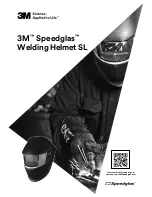
Page 18
Studio Reference
IIIII
&
II
II
II
II
II
Professional Studio Amplifiers
available from most electrical supply stores.
3.3.6 Additional Load Protection
Studio Reference amplifiers can deliver very high
power levels, so it’s a good idea to add protection for
your loudspeakers if it is not built-in. Loudspeakers are
subject to thermal damage from sustained overpower-
ing and mechanical damage from large transient volt-
ages. In both cases, fuses may be used to protect your
loudspeakers, or you may opt for the convenience of a
P.I.P. module that provides similar protection.
Thermal protection and voltage protection require dif-
ferent types of fuses. Slow-blow fuses are used to pre-
vent thermal damage because they respond to thermal
conditions like a loudspeaker. High-speed instrument
fuses like the Littlefuse 361000 series are used to pro-
tect loudspeakers from transient voltages. The nomo-
graph in Figure 3.16 can be used to select the correct
fuse for thermal or voltage protection.
There are two common ways to install the fuses. One
approach is to put a single fuse in series with each out-
put. This is easy because there is only one fuse per
channel to install. But if the fuse blows, power is re-
moved to all of the connected loads.
A better approach is to fuse each driver independently.
This allows you to apply the most appropriate protec-
tion for the type of driver being used. In general, low-
frequency drivers (woofers) are most susceptible to
thermal damage and high-frequency drivers (tweeters)
are usually damaged by large transient voltages. This
means that your loudspeakers will tend to have better
protection when the woofers are protected by slow-
blow fuses and high-frequency drivers are protected
by high-speed instrument fuses.
Depending on the application, you may want to use a
specialized
P.I.P. module to protect your loudspeak-
ers. Again, some modules are more appropriate for
long-term thermal protection, while others are more ap-
propriate for protection against transients. A
Smart Amp
™
IQ-P.I.P. module is most commonly used
for long-term loudspeaker thermal protection. Each
Smart Amp channel provides an independent “smooth
output limiter” that controls average output levels over
time while it allows transients to pass.
Most of the other
P.I.P. modules that provide signal-
driven compression can be used to prevent loud-
speaker damage from transient voltage. These
modules include the P.I.P.-AMCb, P.I.P.-EDCb and
P.I.P.-PA. While the P.I.P.-EDCb is most commonly
used for general loudspeaker protection, the
P.I.P.-AMCb is very popular in systems that require a
high-quality crossover, and the P.I.P.-PA is the proces-
sor of choice for applications that require a microphone
and line level input for each channel. And finally, the
Smart Amp IQ-P.I.P.-DP provides both an input com-
pressor for transient protection and a smooth output
limiter for long-term thermal protection. For more infor-
mation on
P.I.P. modules, see Section 8.
3.4 AC Mains Power
All
Studio Reference amplifiers are shipped with an
appropriate line cord and plug. The 120 VAC, 60 Hz
North American
Studio Reference
I
has a special
TT30P plug and includes a matching receptacle. Al-
ways use an isolated power receptacle whenever pos-
sible with adequate voltage and current. Excessive line
voltages 10% or higher above the rated voltage will
cause the amplifier to activate its standby mode (see
Section 4.3.2). For example, do not exceed a 132 VAC
with models rated for 120 VAC operation.
Unless otherwise noted, all specifications in this
manual were measured using 120 VAC, 60 Hz power
mains with voltage accurate to within 0.5% and THD of
less than 1.0% under all test conditions. Performance
variations can occur at other AC mains voltages and
line frequencies. Line regulation problems will directly
affect the output power available from the amplifier.
Fig. 3.16 Loudspeaker Fuse Nomograph
1.0
1.2
1.4
1.6
2.5
3
4
5
6
7
8
9
10
12
14
16
20
25
30
20
15
10
8
6
5
4
3
2
1.5
1
.8
.6
.5
.4
.3
.2
.15
.1
.08
3000
2000
1500
1000
800
600
400
300
200
150
100
80
60
40
30
20
15
10
8
6
4
3
2
1.5
1
LOUDSPEAKER IMPEDANCE
(ohms)
FUSE
(amps)
LOUDSPEAKER RATING
PEAK MUSIC POWER
(watts)
(Typically 4 times the continuous average power)
Answer: Fuse = 1.5 A
2
40
Example:
Impedance = 8 ohms.
Peak Power = 75 W
















































